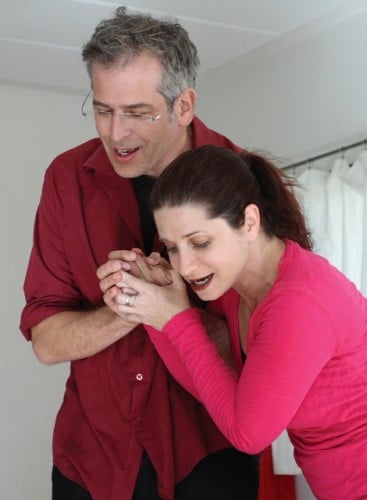Rarely, in relationships between people, moments of grace occur where two people, or more, feel a miraculous coordination, that they are really in one mind. Prof. Uri Alon studies this phenomenon

Prof. Uri Alon and Yael Ben-Ari. Wonderful coordination
"Rarely, in relationships between people, there are moments of grace in which two people, or more, feel a miraculous coordination, that they are really in one mind. "When this happens, the breathing stops," says Prof. Uri Alon from the Weizmann Institute of Science. "It happens to children who play together, to jazz players who report after the fact that 'the music played us', even to football players, and also to theater players."
What, really, is going on there, in the minds of the people who are in a state of "miraculous coordination"? Prof. Alon had a moment of "wonderful coordination" with Dr. Lior Noy, in which they understood how this elusive phenomenon could be investigated ("How to create a moment like this in the laboratory, proactively?"). An original research method led them to findings recently published in the scientific journal "Records of the American Academy of Sciences" - PNAS.
The solution stemmed from the experience of Prof. Alon and Dr. Noy as playback theater actors - an improvisational theater based on stories from the audience. In theater training, actors perform a "warm-up" exercise called the mirror game. The exercise is designed to free players, and help them create together. Dancers also usually perform it before training, or a performance, in order to reach a state of "miraculous coordination". The mirror game takes place when two people stand in front of each other, and one of them tries to follow the movements of the other - and imitate him as accurately as possible. At the beginning of the exercise, they determine who is imitating whom, or, in the words of the players, who is the leader and who is being led. After a while, the director instructs to switch roles, and in the third stage nothing is determined: the two actors act against each other, when it is not defined who leads and who is led. This is the stage where the "miraculous coordination" sometimes takes place.
Prof. Alon and Dr. Noy decided to approach the question with a classical physical approach: if a certain system is too complex for us to study it in a controlled manner, we can use a model with a reduced number of dimensions, and try to tap from it what is happening in the more complex system. Thus, instead of a system (theater actors, for example), which operates in the three dimensions of space and the dimension of time, they decided to settle for a system that operates in one of the dimensions of space, and the dimension of time. For this they created a kind of game board on which two handles are installed, each of which can move along a straight slot. The two slots are parallel to each other, and the two players move the handles with one of them leading and the other being led, thus, until the stage where they operate without pre-setting who leads and who is led. The scientists tested in the facility actors with experience in improvisation (theatre actors, jazz players, etc.), as well as inexperienced actors.
The experienced players were able to create quite complex movements, even though they only had one of the dimensions of space at their disposal. They reached the peak of complexity and coordination at a stage where it was not defined who was leading and who was being led. The scientists precisely measured the distance between the handles of the two players, the degree of coordination between them when stopping, and more. This is how it turned out, that in the phases where it is defined who is leading and who is being led, it is possible to notice a kind of "vibration" with a frequency of two to three hertz in the movement speed of the player being led around the movement of the leader. On the other hand, when there is no defined leader and led, the two players can enter a situation where they move the handles in smooth movements without vibration, with "miraculous coordination". The movement looks like two leaders agreeing on a complex future movement.
On the other hand, in the group of inexperienced players, not defining a leader and a led caused an uncoordinated and hesitant movement. When there was a defined leader, their performance improved.
As a basis for understanding the coordination phenomenon, the scientists developed a mathematical model, similar to control systems for tracking a moving target. "The model contains two main factors," says Prof. Alon, "one predicts the movement of the 'target', and the other controls it - correcting mistakes between what is desired and what is found." The internal auditor has a rate constant that causes vibration at a frequency of two to three hertz. When we ran two such models playing against each other, the two 'contracts' connected in a kind of 'miraculous coordination', while the two critics canceled out. The result was obvious: the movement of both converged into a smooth, complex and coordinated movement, without a trace of the 'vibration' of the visitors."
Following this research, a theater laboratory was established at the Weizmann Institute, where scientists and actors work together. The intention is to enable a controlled scientific investigation of complex phenomena in human behavior and relationships between people, using concepts and tools developed in the theater world.

One response
Could you please link to the study that was published? It is very interesting. Thanks.